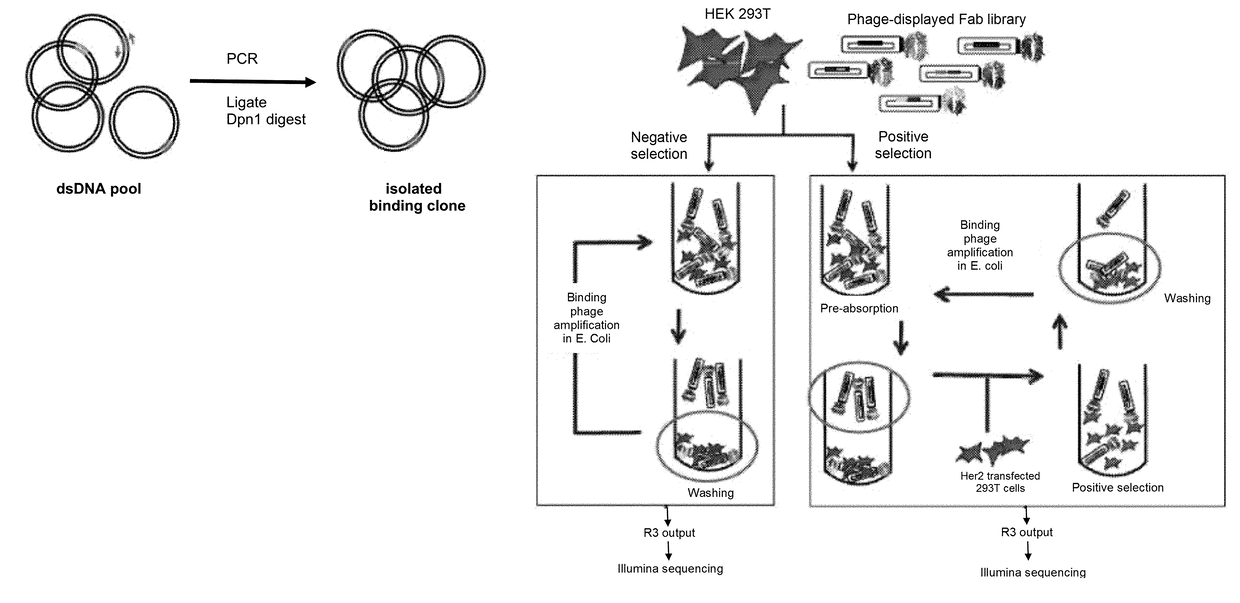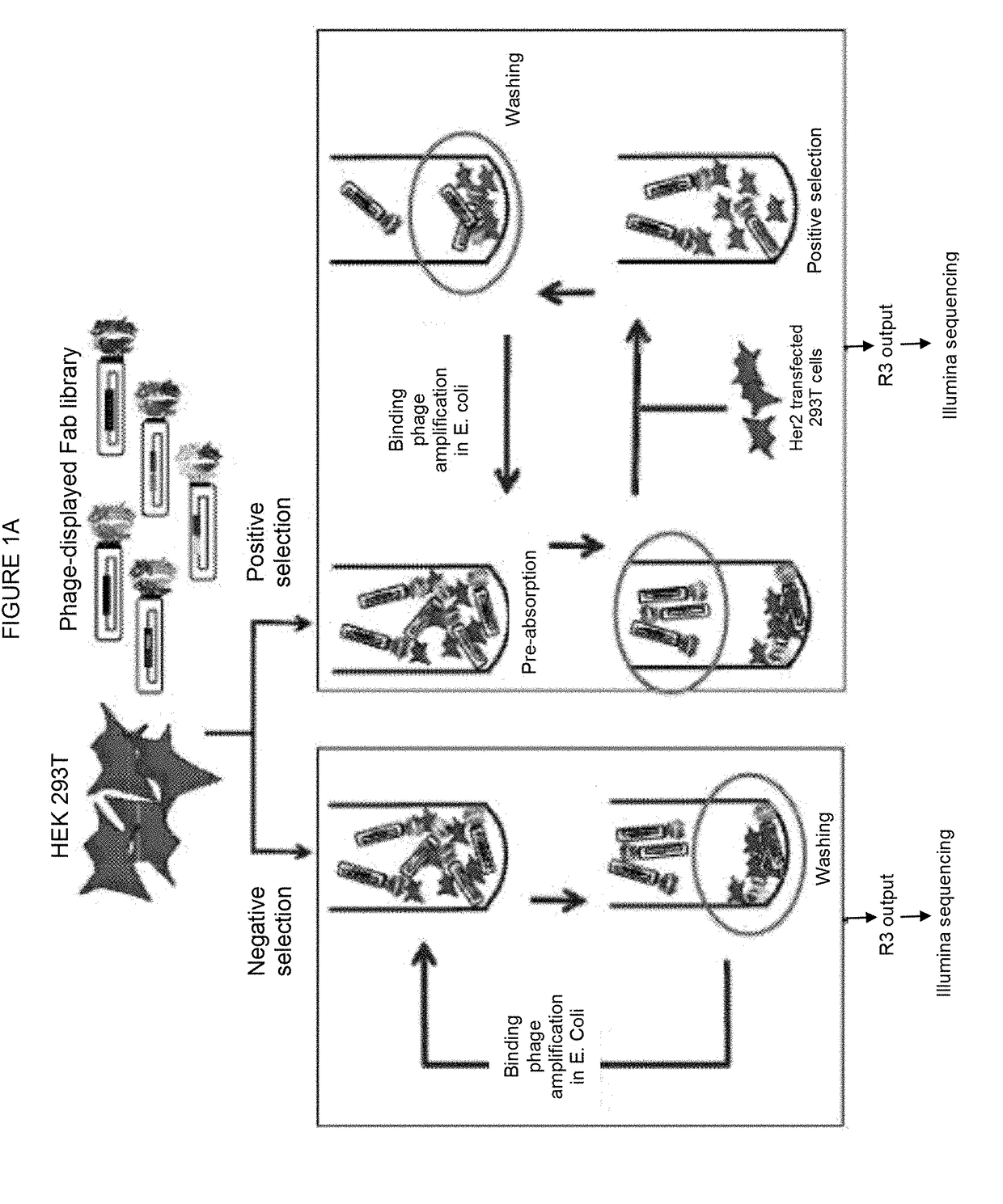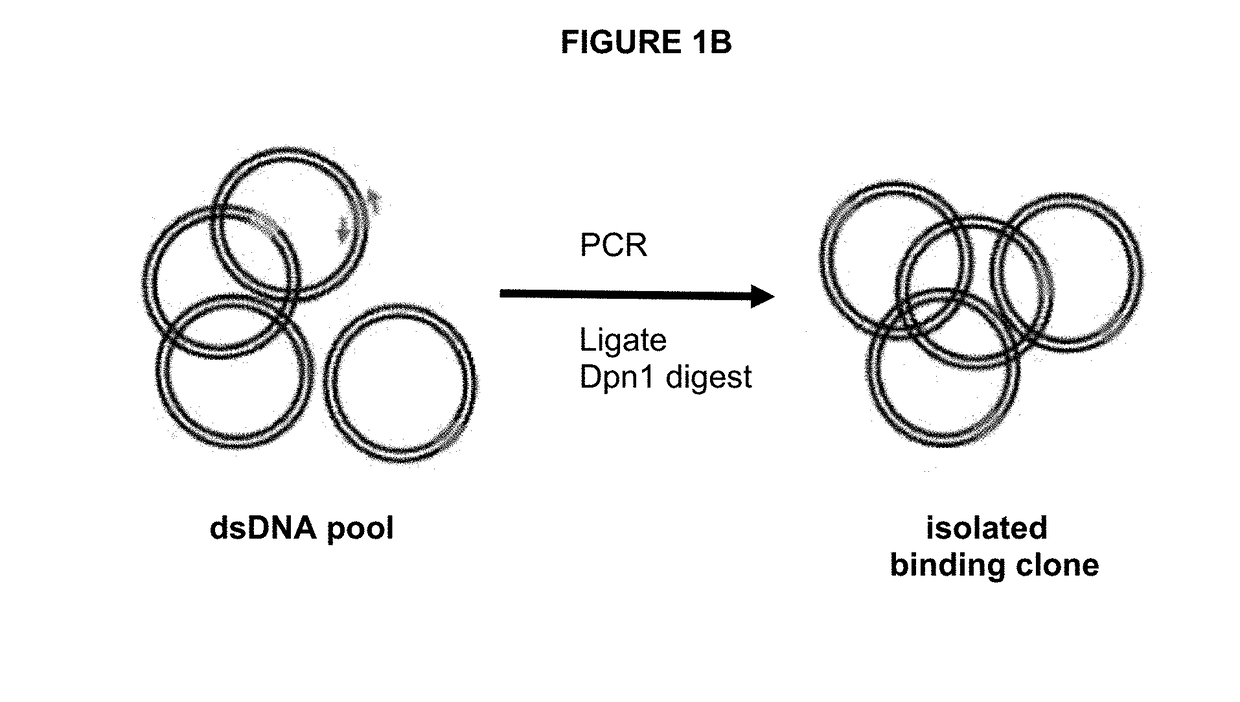Molecular Display System
a molecular display and molecular target technology, applied in the field of molecular display methods, can solve the problems of poor enrichment of cell surface antigens, difficult selection of libraries against cell-surface antigens, and inability to obtain certain epitopes for binding, etc., and achieve the effect of rapid and efficien
- Summary
- Abstract
- Description
- Claims
- Application Information
AI Technical Summary
Benefits of technology
Problems solved by technology
Method used
Image
Examples
example 1
Rapid Isolation of Antibody Fragments to Cell-Surface Targets
[0070]The considerable heterogeneity of cell-surfaces makes selection of phage-displayed antibody libraries against cell-surface antigens challenging. We report the development of a unique methodology for rapidly isolating phage-displayed antibody fragments to cell-surface targets, using the oncogenic human epidermal growth factor receptor 2 (Her2) as a model. Synthetic phage-displayed libraries were selected in parallel on Her2-positive and negative cells. Following three rounds of selection, the output phage pools were analyzed by Illumina deep sequencing. Comparisons of the sequences from the positive and negative selection pool allowed sequences specific to the antigen-expressing cell-line to be readily identified from background phage clones. A PCR amplification strategy that used primers specific to the unique heavy chain third hypervariable loop enabled the recovery of clones from the positive selection pool, which ...
example 2
PCR-Based Recovery of Antibody Fragments to Additional Cell-Surface Targets
[0098]The rescue strategies described herein make use of both the unique H3 and L3 CDR sequences.
[0099]As an alternative to identifying positive Fabs by clonal cell ELISAs, two different PCR based recovery methods are used (FIGS. 6A, 6B). As depicted in FIG. 6A, two primer sets specific for both CDR H3 and L3 are used to make the recovery more specific. Primers are designed to anneal to the L3 and H3, and amplify two fragments, in both directions. This results in two fragments that both contain the L3 and H3 regions. The two fragments can be annealed, and then a single round of DNA extension is done. The resulting product can then be ligated and transformed into E. coli to recover the desired phage clone in the original library display vector. As depicted in FIG. 6B, three primer sets are used to amplify three fragments, in a strategy that makes use of both the H3 and L3 unique sequences and unique Nsi1 and N...
example 3
Rapid Isolation of Antibody Fragments Specific to Cell Growth Conditions
[0101]FIG. 7 depicts a flow chart of the selection strategy used to isolate Fab clones specific for cell surface O-GlcNAc-dependent epitopes, demonstrating that the CellectSeq method can be used to isolate Fabs specific to cell growth conditions. The positive selection begins a pre-absorption step in which the library phage are incubated with MCF7 breast cancer cells grown in DMEM (Dulbecco's Modified Eagle Medium) (high glucose version) supplemented with 10% FBS. After incubation, the mixture is pelleted to remove the library clones bound to the cells. These clones are likely specific for cell-surface epitopes that are not of interest, or are non-specific binding clones. The library phage remaining in the supernatant are incubated with the MCF7 cells grown in DMEM (high glucose version) supplemented with 10% FBS plus 30 mM Glucosamine (G), 5 mM Uridine (U) and 50 μM PugNAc (P) (collectively referred to as GUP),...
PUM
| Property | Measurement | Unit |
|---|---|---|
| temperature | aaaaa | aaaaa |
| flow rate | aaaaa | aaaaa |
| surface | aaaaa | aaaaa |
Abstract
Description
Claims
Application Information
 Login to View More
Login to View More - R&D
- Intellectual Property
- Life Sciences
- Materials
- Tech Scout
- Unparalleled Data Quality
- Higher Quality Content
- 60% Fewer Hallucinations
Browse by: Latest US Patents, China's latest patents, Technical Efficacy Thesaurus, Application Domain, Technology Topic, Popular Technical Reports.
© 2025 PatSnap. All rights reserved.Legal|Privacy policy|Modern Slavery Act Transparency Statement|Sitemap|About US| Contact US: help@patsnap.com



